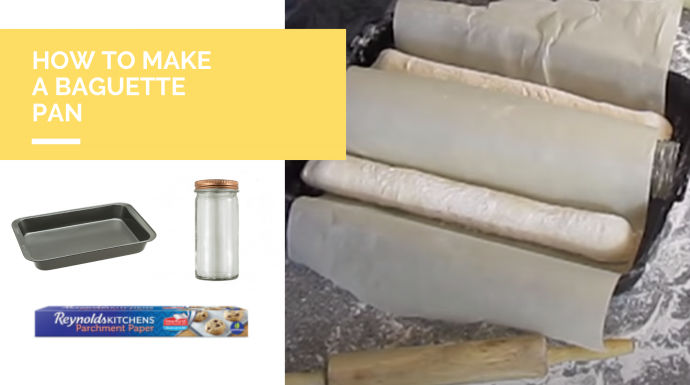Homemade French Baguette Without a Special Pan

You will need: 1 large mixing bowl, 1 large wooden/polycarbonate mixing spoon, measuring cups and spoons, baking pan with borders (choose according to your baguette length preference), a couple of jam jars to create an improvised border inside for the breads, baking parchment, kitchen towels.

To make an improvised baguette pan, take
a simple baking pan, line up the jars to
form a border in the middle and cover
with baking parchment, so you will be
able to put the dough in between.
Very yummy, and a great way to make fresh French bread at home without a special equipment.
Ingredients
1 tablespoon active dry yeast (or scant tablespoon instant yeast)
1⁄2–1 tablespoon sugar
2–21⁄2 cups warm water (105–110°F)
6 cups unbleached flour (or may use all unbleached all-purpose)
1 tablespoon salt
Oil/butter for coating bowl
Directions
1. If you are using active dry yeast, sprinkle the yeast on warm water then sprinkle with sugar. Dissolve yeast and wait until foamy. If you’re using instant yeast, you can skip this step and add the yeast to the flour.
2. Add the yeast/water, and all but 1⁄4 cup of flour, together in the large bowl. Mix together with your hands or with the spoons until the dough is combined and shaggy. Turn the dough out onto your work surface, cover with the bowl, and allow the dough to rest for 5 minutes.
3. After the rest, remove the bowl from the dough and knead until gluten window is present. The dough should be moist, but no longer sticky. Clean the bowl, and then add the oil. Shape the dough into a ball. Place smooth side down into the bowl, spin three times and flip. The smooth, oiled side will be up.
4. Cover the bowl with plastic wrap and place in a comfortably warm, room temperature spot. Allow the dough to rise for at least 3 hours. Every half hour, lift one side of the dough and turn it onto the rest of the dough, and replace the wrap. Don’t over handle or “punch” the dough. The movement should be gentle.
5. When your dough has completed the first rise, carefully ease it from the bowl onto your work surface.
6. Divide dough into equal portions. For the first shaping, push or press the dough with your fingers into a square about 4×4 inches. Starting at the top, fold the dough into thirds as if you are folding a letter. Turn the dough seam side down and cover. Repeat with the other portions of dough. Allow the dough to rest for 15 minutes.
7. Shape into baguettes. Using the same technique, create a rectangle 4×6 inches. Starting on the long side, fold the dough towards you about two thirds of the way and seal with the heel of your hand. Turn the dough so the top is now the bottom and repeat, folding down two thirds and sealing. In the crease you created with the fold, place your thumbs so the tips touch and your fingers are on the top of the dough. Gently push your thumbs into the dough to “snug up” the dough. This will help prevent any open spaces in the finished baguette. Roll the top of the dough toward you one-half roll, then seal. Roll a bit more, and seal. Complete the roll and seal. Roll the small log-shaped baguette onto the seam.
8. Cover and rest for 10 minutes. Uncover the dough. Give yourself plenty of room. Using palms and fingers, roll from the center out, gently rolling the dough to the length of an improvised pan. Lift the dough and set in the pan. When you’ve finished all the baguettes, cover and allow to rise for 1 to 11⁄4 hours.
9. While your bread is rising, preheat your oven to 450°F.
10. When the rise is complete, make 4- to 51⁄4-inch diagonal slashes across the top of the bread (with fast movements). This will help the bread expand and not burst out the sides in unexpected places. Try to start each slash just before the previous one ends. This will prevent bursts on the top.
11. Place in 450°F oven, then immediately reduce the oven temperature to 425°F.
12. Bake for 8 to 10 minutes, reduce oven to 375–400°F and finish baking for approximately 15 to 20 minutes more. The bread should be medium to deep golden brown. Turn off the oven, remove the bread from the pan, and place the bread back in the oven directly on the oven rack. After 5 minutes, open the oven door slightly, a few inches. Allow the baguettes to cool in the oven. This will help set the crust.
TIP! Baguettes have a short shelf life and should be eaten within 1 to 5 hours. If you need to store your bread, wrap in plastic wrap. Your bread may soften. To recrisp, place in 350°F oven for 5 to 10 minutes. To freeze, roll in long strips of plastic wrap, twist the ends, then place in grocery bags. Try to create several layers between the bread and the freezer environment.
Give it a try!


